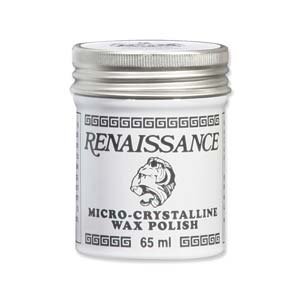 “…and coated with an archival wax…” So what is it? Archival wax is a preservative coating that protects an object from dust, dirt and fingerprints while allowing it to “breathe”. Unlike a varnish, this type of coating does not seal the pores of wood or in our case ivory – not like a plastic coating anyway. This fine wax coating penetrates the pores and protects the surface. This is different from a plastic coating because it is so thin, fluctuations in barometric pressure will allow the gasses inside the pores to pass through the wax, whereas a plastic coating will inhibit this. You will also find that a varnish or urethane coating will eventually craze, archival wax will not.
“…and coated with an archival wax…” So what is it? Archival wax is a preservative coating that protects an object from dust, dirt and fingerprints while allowing it to “breathe”. Unlike a varnish, this type of coating does not seal the pores of wood or in our case ivory – not like a plastic coating anyway. This fine wax coating penetrates the pores and protects the surface. This is different from a plastic coating because it is so thin, fluctuations in barometric pressure will allow the gasses inside the pores to pass through the wax, whereas a plastic coating will inhibit this. You will also find that a varnish or urethane coating will eventually craze, archival wax will not.
“Renaissance Wax Polish will protect the surface of metals and wood from dust, fingerprints, liquids, and other environmental hazards. Renaissance wax polish was originally formulated in the British Museum research laboratories in the early 1950’s, in response to a discussion amongst museum technicians at an international conference on fine-art conservation. When applied, it creates a micro-thin, lustrous layer that enhances shine while preventing damage.”
I find this works very well as long as your piece is thoroughly dry – this is especially important when you are working with oil paint – the renaissance wax can dissolve and lift out any unhardened oil paint. If you are working under a deadline, you may wish to use India ink as your medium since it dries much faster (hours instead of weeks). India ink may also be helpful if you are creating scrimshaw while the customer waits – not my preferred method of scrimshaw, but not unheard of (I really don’t “pine for the good ol’ days” working in a kiosk in the mall!). Available at Amazon
where can i get this wax and will it work on a powder that is being used?
Hello Jerry,
On our page https://www.scrimshaw.com/archival-wax/ You can find out all about the archival wax we use. It should work fine on (I am figuring it’s a powder horn?) horn, just be sure the pigment you use is completely dry – say for a couple of weeks before you put it on. I did find using oil paint and NOT waiting more than two weeks resulted in some of the pigment lifting out of the incisions. Once dry, it should be fine. Hope this helps, and send a picture if you would of your creation – we’d love to see it! (I have a horn waiting patiently for me to get back to scrimshawing, so a picture may inspire me!)